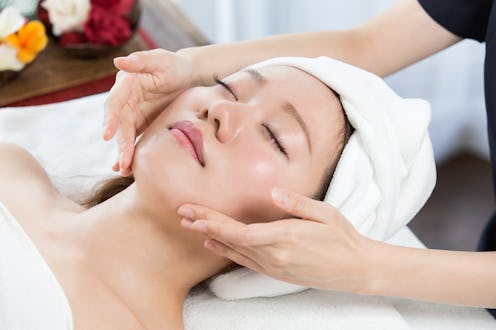Beauty
Everything To Know About The Benefits Of Dermaplaning
Does shaving your face really have any benefit?

From TikTok to YouTube how-tos, it seems like everyone has been talking about dermaplaning. The beauty treatment isn’t brand new and it’s easy to dismiss as another empty influencer trend. But if you want smooth and bright skin, shaving your entire face might be the way to get it.
But is dermaplaning safe? Can it be done at home? There are a lot of questions (as there should be). To answer them all and to learn everything you need to know about the scalpel taking over your social feeds, see what the experts had to say about dermaplaning below.
What Is Dermaplaning?
Dermaplaning involves using a sharp, scalpel-like tool to scrape off dead skin off the face. Usually done by a dermatologist or licensed esthetician, it is another form of exfoliation that can also unclog pores and remove unwanted peach fuzz to give you a brighter complexion.
“The treatment is great if you are looking to exfoliate the face, get rid of unwanted facial hair, and help makeup go on smoother,” says board-certified dermatologist and assistant clinical professor of dermatology at the Mount Sinai School of Medicine Dr. Jeannette Graf. “It also stimulates collagen production by regulating specific growth factors which can result in firmer feeling and healthier skin.”
Graf adds that dermaplaning is pretty surface level and won’t penetrate the skin or hair follicles deep enough to remove hair permanently. A dermatologist or esthetician will be able to help you figure out how many times you should do this treatment, but she does say that you should generally wait at least three or four weeks between sessions.
What The Benefits Of Dermaplaning?
As mentioned above, some benefits to dermaplaning include smoother texture, increased collagen production, and a brighter complexion. If you’re looking to get rid of facial hair, dermaplaning is also a great option for removing peach fuzz.
Is There Any Downtime?
Downtime is pretty minimal but for best results, you’ll want to prep the skin correctly before your treatment. Dr. Joyce Imahiyerobo-Ip, a Boston-based board-certified dermatologist and CEO of Vibrant Dermatology and Skin Bar, says to avoid using harsh chemical exfoliants before (and even after) treatment. Imahiyerobo-Ip also says you’ll want to wash your complexion with a gentle cleanser to get rid of any dirt and debris and to get skin ready for the dermaplaning tool.
After treatment, she says that skin may feel dry or even a little irritated from all the tugging that goes on. She recommends using a moisturizer to provide hydration and using something like Vaseline’s Original Healing Jelly to soothe and heal any irritation.
Graf also recommends using a sunscreen post-treatment, like ISDIN Eryfotona Ageless, or a moisturizer with an SPF in it, like Charlotte Tilbury’s Magic Cream Light with SPF 20 and blue light protection. It’s crucial to protect newly exfoliated skin from harmful UV rays.
What Are The Side Effects?
When done by a professional, dermaplaning is fairly safe for most people. Graf says irritation and infection occur if the technician performing the treatment isn’t using a sterile blade. She also says that if you have any flaring skin conditions (these include things like acne, acne scars, or sunburns), you should avoid a dermaplaning treatment as it would make those conditions worse and result in further injury.
Edyta Jarosz, a licensed esthetician at Shafer Clinic Fifth Avenue, agrees and adds that there is a chance that some hairs grow back darker or thicker. She says it’s extremely rare, but is something to be aware of.
Is It Safe To Try Dermaplaning At Home?
The short answer is yes. But all experts caution against it and encourage people to see a dermatologist or licensed esthetician for any and all dermaplaning treatments. “In my opinion, this procedure should be performed by a skin professional,” says Jarosz. “If not done correctly, dermaplaning at home can cause scarring and possible cuts from scalpels, [which] can easily get caught on the skin and be dragged down.”
Experts agree that those especially prone to any type of sensitivity should avoid dermaplaning all together. “Because [it] involves the use of a sharp object, the number one concern with [at]-home dermaplanning is that improper technique will lead to injury to the skin,” says Imahiyerobo-Ip. “Don’t dermaplane if your skin is physically compromised.” She says that physically compromised skin includes skin concerns like rashes, sensitivity, and acne.
If you still want to try it out (and if your skin can take it), there are few simple steps you can follow. Licensed esthetician at Perfect Image Skincare Courtney Rashidi says you must damp the skin as a first step. Then you’ll want to make sure that the dermaplaning tool is parallel to the skin as you gently start scraping the skin with the device. Rashidi recommends drawing the blade in the direction of hair growth to avoid creating any abrasions. She also says you’ll want to dermaplane your entire face as opposed to just certain sections to get your complexion as smooth as possible.
As for picking the right product for your at-home needs, Graf recommends something like the DERMAFLASH LUXE Anti-Aging Exfoliation & Peach Fuzz Removal Device. While she hasn’t tried it herself, she also says her patients have been raving about StackedSkincare Dermaplaning Face Exfoliating Tool. There’s also TikTok favorite, Jill’s Starter Kit, the world’s first female face razor subscription if you’re looking for a wallet-friendly option.